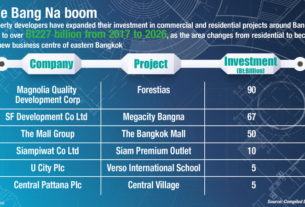
Fewer deals in Bangkok as land demand dips
Prices kept rising despite economic woes
Slowing condo launches and extremely high land prices in inner city areas led to a year-on-year increase in land prices in Bangkok during the fourth quarter last year as it saw the lowest growth in a decade, according to property consultant CBRE Thailand.
Barnaby Swainson, head of investment and land at CBRE Thailand, said land demand, especially for high-rise condo development in the central business district (CBD), had fallen, resulting in fewer land transactions in the past few years.
“Last year there had been no new condo launch in CBD for almost three quarters in a row,” he said. “Prices for sale are currently at high levels, making them not viable for new development.”
According to the Real Estate Information Center (REIC), the price index of vacant land in Greater Bangkok in the fourth quarter of 2021 had the lowest year-on-year increase since the survey was started in 2012.
The index in the fourth quarter last year was 339, a 1.4% quarter-on-quarter increase and rising only 1.7% year-on-year.
The previous lowest year-on-year increase in history was in the first quarter of 2016 at 2.7%, followed by the second quarter of the same year at 3.8%.
“Despite the economic slowdown, land prices kept rising,” said Vichai Viratkapan, REIC’s acting director-general.
“But the year-on-year increase has slowed consecutively for six quarters since the third quarter of 2020.”
He said the lower increase in the land price index was mainly attributed to the construction progress of new mass transit lines which would be completed within this year.
During 2015-2019, the five-year average increase in vacant land price index was 14.8% per year and 4.1% per quarter.
The majority of locations where the price index was higher in the fourth quarter of 2021 were in eastern Bangkok as the area had many mass transit lines under construction or nearly complete.
Mr Swainson said the low volume of investment transactions over the last two years was mainly derived from the mismatch in price expectations between buyers and sellers.
“During the initial stage of the pandemic in 2020, the mismatch was greatest, perhaps 30% differential on average. Buyers required a discount but sellers wanted to observe how the market prices could recover,” he said.
Going into 2021-22, the mismatch differential is less. CBRE would typically generalise at 10-20% but seeing the growing number of transactions, in some cases this was clearly a bridgeable gap.
“We expect to see a narrower gap and more potential for investment transactions, driven by the expectation that 2022 will be the start of the recovery,” he said.
As price expectations change, there will be increasing interest from overseas investors.
Developers will look for joint venture partners to help finance their new projects while local banks remain cautious of lending during the current property cycle.
Mr Swainson said there were various types of assets that overseas buyers were interested in.
However, those most likely were linked to their core business in their home country. The most common demand CBRE saw was for logistics, hospitality and office.
There were also some demand for apartments, data centres and retail.
The target yield and internal rate of return (IRR) varied greatly depending on the type of investor and investment, but as a broad guide, IRRs higher than 10% were sought.
While the condominium sector had been the preferred sector for joint ventures, this year other sectors might also draw greater attention, particularly offices and the industrial asset and logistics market.
“Investors should consider properties with value-added potential in both the hotel and office sectors where required renovation and asset improvements may create buying opportunities from passive owners,” he said.
Source: https://www.bangkokpost.com/business/2261119/fewer-deals-as-land-demand-dips


